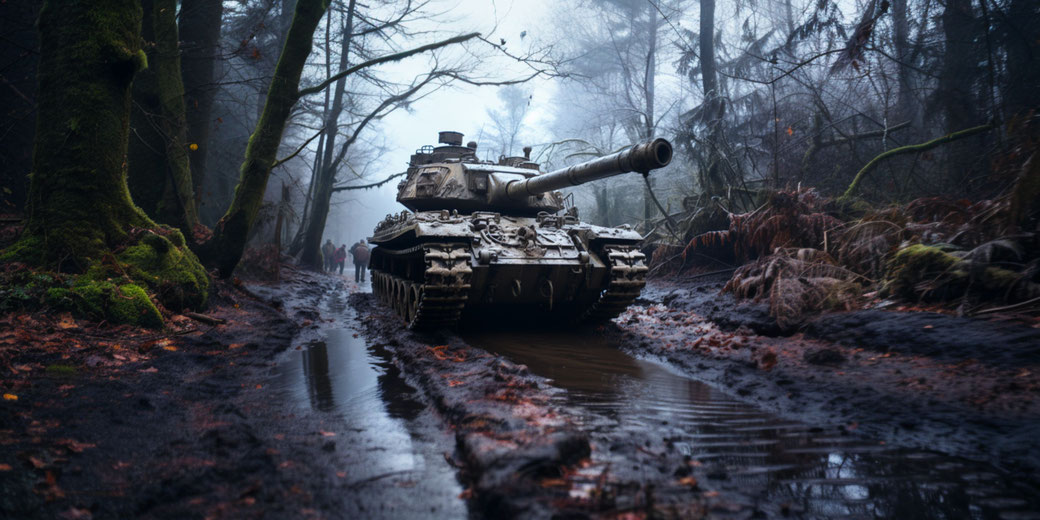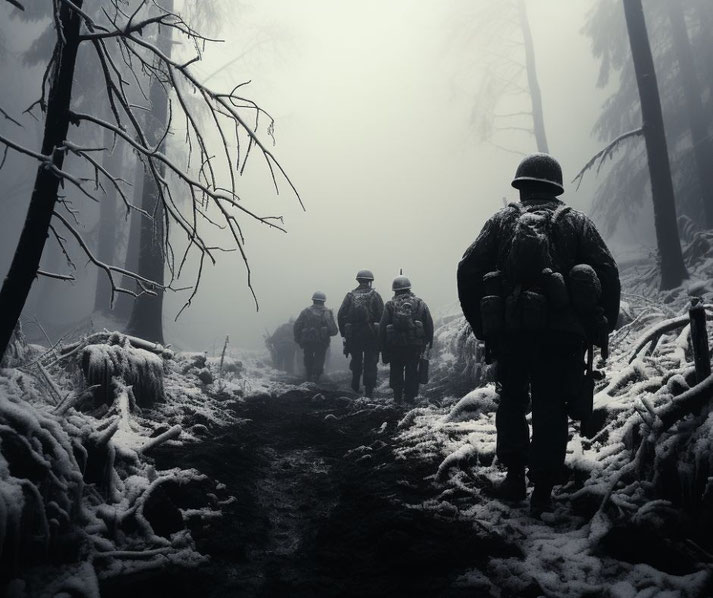Battle of the Bulge: Hitler's desperate last attempt to win World War II

In the frostbitten winter of 1944, the Ardennes Forest became the unlikely stage for one of World War II's most intense and decisive battles: the Battle of the Bulge.
This surprise German offensive against the Allied forces tested the military strategies and physical limits of both sides.
But what were the strategic objectives behind Hitler's massive German assault?
How did the Allied forces, caught off guard, manage to regroup and counter this unexpected threat?
And what were the lasting impacts of this brutal confrontation on the course of the Second World War?
Why did Hitler launch the Battle of the Bulge?
By late 1944, the Allied forces had liberated much of France and Belgium following the successful D-Day landings in Normandy on June 6, 1944.
The rapid advance across France had led to an overextended supply line for the Allies and a temporary slowdown in their advance by the fall of 1944.
This slowdown provided the Germans with a crucial opportunity to regroup and plan a counteroffensive.
The German High Command, under Adolf Hitler's direct order, began planning a surprise offensive intended to turn the tide of the war in their favor.
The objective was to split the British and American lines, capture the vital port of Antwerp, and encircle four Allied armies, forcing the Western Allies to negotiate a peace treaty in favor of the Axis powers.
This plan was a high-stakes gamble by Hitler, who believed that a decisive victory could change Germany's fortunes despite the increasingly unfavorable overall military situation.
The Ardennes region was chosen for the attack due to its perceived weak defense, consisting primarily of American troops who were either inexperienced or exhausted from previous battles.
The dense forests and rugged terrain of the Ardennes had also seen the successful German advance during the invasion of France in 1940, leading the Germans to believe that a repeat success was possible.
The German plan, codenamed 'Operation Watch on the Rhine', involved assembling a large number of troops and vehicles in complete secrecy.
This secrecy was maintained through strict radio silence and the movement of troops under cover of darkness.
By early December 1944, the Germans had quietly amassed a significant force, including several Panzer divisions, in the region, unbeknownst to the Allies.
Which side had the strongest army?
On the German side, the offensive was primarily led by the Heeresgruppe B (Army Group B), commanded by Field Marshal Walter Model, a seasoned commander known for his defensive expertise.
However, the strategic planning and overall direction came from Adolf Hitler himself, who remained deeply involved in the operational details.
The German forces were divided into three main groups for the attack: the Sixth Panzer Army under SS-Oberstgruppenführer Sepp Dietrich, the Fifth Panzer Army under General Hasso von Manteuffel, and the Seventh Army under General Erich Brandenberger.
These armies were a mix of seasoned veterans and newly formed units, equipped with tanks, infantry, and artillery.
Notable among these were the elite Waffen-SS units, including the 1st SS Panzer Division Leibstandarte SS Adolf Hitler, which were expected to lead the charge and break through the Allied lines.
The Allied forces in the Ardennes region were primarily American, with the bulk of the defense initially resting on the shoulders of the U.S. First and Third Armies.
The U.S. First Army, commanded by General Courtney Hodges, occupied the northern sector of the Ardennes, while the U.S. Third Army, under the command of the charismatic General George S. Patton, was positioned to the south.
These forces included a mix of veteran and newly arrived units. Among them were the 101st Airborne Division, famously involved in the defense of Bastogne, and the 82nd Airborne Division.
The American forces were supported by elements of the British XXX Corps, part of the British 21st Army Group under Field Marshal Bernard Montgomery, who later played a crucial role in reinforcing the American positions and counterattacking the German advance.
The surprise German attack
The German offensive that marked the beginning of the Battle of the Bulge commenced in the early hours of December 16, 1944, under the cover of dense fog and harsh winter weather, which played a crucial role in neutralizing the Allied air superiority.
The Germans launched their attack along a 70-mile front, stretching from Monschau in the north to Echternach in the south, targeting the thinly stretched American lines in the Ardennes Forest.
The offensive was spearheaded by three German armies. In the north, the Sixth Panzer Army, led by SS-Oberstgruppenführer Sepp Dietrich, aimed to break through the Allied lines and capture the bridges over the Meuse River, a critical step towards reaching the ultimate objective of Antwerp.
The central thrust was led by the Fifth Panzer Army under General Hasso von Manteuffel, which aimed to capture Brussels.
In the south, the Seventh Army, commanded by General Erich Brandenberger, was tasked with protecting the flank of the offensive.
The initial assault took the Allies by surprise. The Germans used a combination of infantry and armor, supported by artillery, to punch through the American lines.
The inclement weather conditions initially grounded the Allied air forces, giving the Germans a significant advantage.
The first days of the offensive saw rapid German advances. Key towns such as St. Vith fell into German hands.
In particular, after fierce fighting from December 16–21, 1944, U.S. forces, including the 7th Armored Division, delayed the German advance.
The Germans secured St. Vith on December 21, but the delay significantly disrupted their offensive timetable.
The American lines were pushed back creating the 'bulge' in the Allied front that gave the battle its name.
One of the most infamous incidents occurred on December 17, when members of Kampfgruppe Peiper of the Waffen-SS Panzer division, who were advancing on Allied positions, massacred 84 American prisoners of war near Malmedy, an act that later became known as the Malmedy Massacre.
This event, among others, contributed to the resolve of the American forces to stand firm against the German onslaught.

How the Allies responded
Initially caught off guard by the scale and intensity of the German attack on December 16, 1944, the Allied forces quickly mobilized a multi-faceted response.
American units, often isolated and outnumbered, fought tenaciously to delay the Germans, buying time for a more organized defense to be established.
The defense of key towns and road junctions, such as St. Vith and Bastogne, played a crucial role in this phase.
Bastogne, in particular, became a symbol of American resilience. Encircled by German forces, the town was defended by the 101st Airborne Division and other units, which held out against repeated attacks and refused to surrender, despite being cut off and surrounded.
General Dwight D. Eisenhower quickly grasped the seriousness of the situation and moved to coordinate a robust counter-response.
One of his first decisions was to reallocate resources and command responsibilities.
He placed General Bernard Montgomery in charge of the northern sector of the front, consolidating British and American forces in that area, while General George S. Patton’s Third Army was tasked with relieving the besieged forces in Bastogne.
What made the battle so difficult to win?
The Battle of the Bulge presented numerous challenges and hardships for both the Allied and German forces, significantly influencing the course and outcome of the battle.
One of the most immediate and impactful challenges was the harsh winter weather.
The battle took place during one of the coldest winters in Europe, with temperatures often dropping well below freezing.
Snow, ice, and freezing rain were constant, severely impacting movement, living conditions, and the ability to conduct military operations.
For the soldiers, these conditions meant dealing with frostbite, trench foot, and the constant struggle to stay warm and dry.
The weather also initially grounded the Allied air forces, which was a significant advantage for the Germans at the onset of their offensive.
The terrain of the Ardennes Forest added another layer of difficulty. The dense forests, rolling hills, and narrow roads made it a challenging battleground.
For the Germans, the terrain initially provided cover for their buildup and surprise attack, but as the battle progressed, the same terrain hindered their advance and supply lines.
For the Allies, especially during the initial phase of the battle, the terrain complicated their defensive efforts and communication.
Logistics posed a significant challenge for both sides. The Germans, advancing rapidly at first, quickly outpaced their supply lines.
Their offensive was heavily dependent on capturing Allied fuel depots, and when this failed, they faced severe fuel shortages.
This shortage hampered their ability to sustain their initial momentum and effectively utilize their armored divisions.
For the Allies, the suddenness of the German offensive meant that they had to rapidly mobilize reinforcements and supplies, often over long distances in difficult winter conditions.

How the Allies turned the tide
The turning of the tide in the Battle of the Bulge, a crucial phase in this pivotal conflict, began towards the end of December 1944.
After the initial shock and setbacks caused by the German offensive, the Allied forces started to regain their footing and initiate a series of actions that would ultimately reverse the course of the battle.
One of the first signs of this shift was the relief of Bastogne. The town had been under siege since December 20, with its defenders, including the 101st Airborne Division, surrounded and cut off from resupply.
Despite being outnumbered and lacking adequate winter gear and supplies, the American troops held out against repeated German assaults.
The siege became a symbol of American resilience. On December 26, General George S. Patton’s Third Army broke through the German encirclement, relieving the beleaguered defenders.
This action not only bolstered Allied morale but also marked a significant strategic setback for the Germans.
By December 23, the dense fog that had blanketed the Ardennes and grounded the Allied air forces lifted.
This break in the weather allowed for the full return of Allied air superiority. The U.S. Army Air Forces and the Royal Air Force launched massive air strikes against German troops, supply lines, and armored columns.
These attacks caused significant disruption to the German supply lines and communication, and directly impacted their ability to sustain the offensive.
In addition to these tactical changes, the Allied command structure and strategy underwent critical adjustments. General Dwight D. Eisenhower, recognizing the gravity of the situation, reallocated resources and streamlined the command structure to respond more effectively to the German offensive.
The improved coordination and reinforcement of the Allied lines bolstered the defense and facilitated a more organized counteroffensive.
By early January 1945, the Allied forces had not only halted the German advance but had also begun their own counteroffensive.
American and British forces started to push back the Germans, regaining lost ground.
The German forces, already stretched thin, facing supply shortages, and under constant aerial bombardment, began to retreat.
The counteroffensive was marked by a combination of aggressive ground assaults and continued air superiority, steadily eroding the gains made by the Germans in the initial phase of the battle.
The culmination of these efforts was evident by mid-January. The Germans were forced into a defensive posture, and by January 25, the original front lines were restored.
The Battle of the Bulge, which had started with a swift and surprising German advance, ended with a decisive Allied victory.
How the Battle of the Bulge impacted the war
The counteroffensive by the Allies, which began in earnest in early January, gradually pushed the German forces back, and by January 25, the original front lines were restored.
The Germans suffered approximately 100,000 casualties, including many experienced soldiers and irreplaceable equipment.
This loss severely depleted the German military's resources and weakened its ability to defend against the advancing Allied forces.
The battle also consumed much of Germany's remaining reserves of men and materiel, leaving little capacity for a sustained defense of the Reich.
For the Allies, the victory came at a high cost, with American forces alone suffering over 75,000 casualties.
These losses included many young and inexperienced soldiers who had been thrust into one of the war's harshest battles.
Despite these losses, the successful defense against the German offensive boosted Allied morale and confidence.
The battle demonstrated the resilience and capability of the Allied forces, particularly the American troops who bore the brunt of the fighting.
The German defeat marked the end of any serious offensive operations by the Wehrmacht on the Western Front.
From this point on, the German army was largely on the defensive, retreating into Germany.
The failure of the offensive also hastened the decline of the German war effort, as resources that could have been used to defend against the Soviet Union's advancing forces on the Eastern Front were instead consumed in the Ardennes.
The Battle of the Bulge marked a significant turning point in World War II.
It represented the last major German offensive on the Western Front and set the stage for the final push into Germany, ultimately leading to the end of the war in Europe.
What do you need help with?
Download ready-to-use digital learning resources
Copyright © History Skills 2014-2025.
Contact via email
With the exception of links to external sites, some historical sources and extracts from specific publications, all content on this website is copyrighted by History Skills. This content may not be copied, republished or redistributed without written permission from the website creator. Please use the Contact page to obtain relevant permission.





